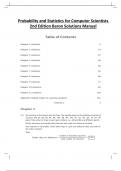Exam (elaborations)
Complete Solution Manual Probability and Statistics for Computer Scientists 2nd Edition Baron Questions & Answers with rationales
- Module
- Institution
- Book
Probability and Statistics for Computer Scientists 2nd Edition Baron Solutions Manual Complete Solution Manual Probability and Statistics for Computer Scientists 2nd Edition Baron Questions & Answers with rationales PDF File All Pages All Chapters Grade A+
[Show more]



